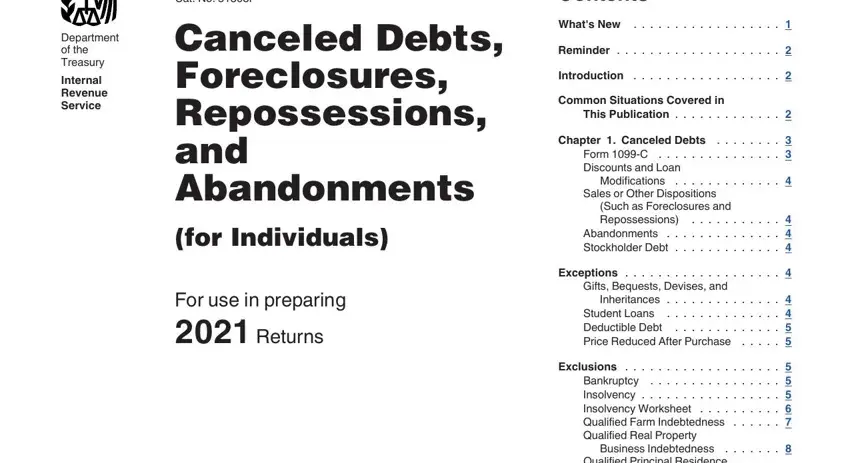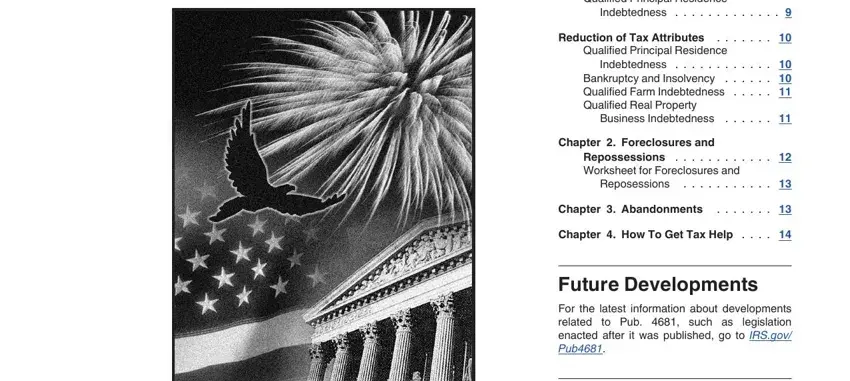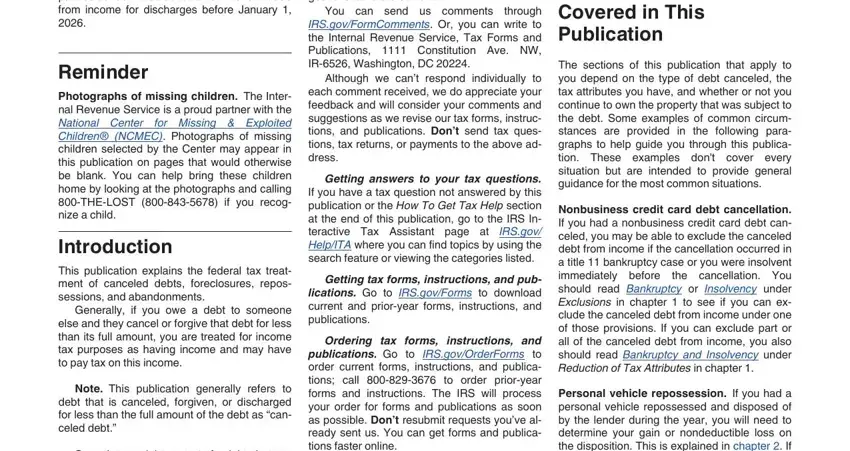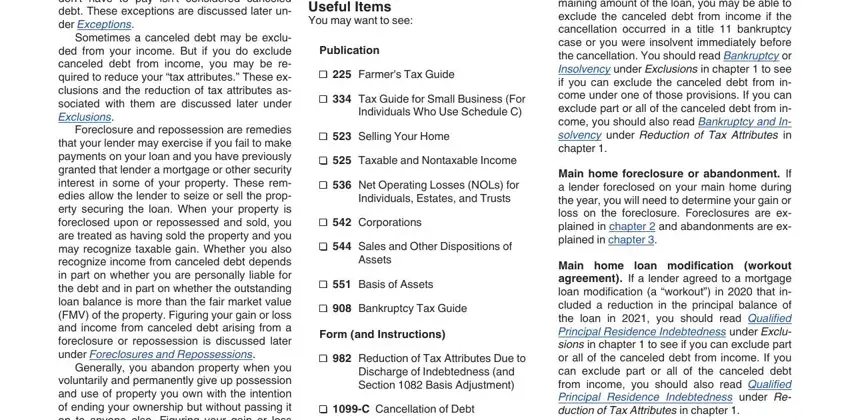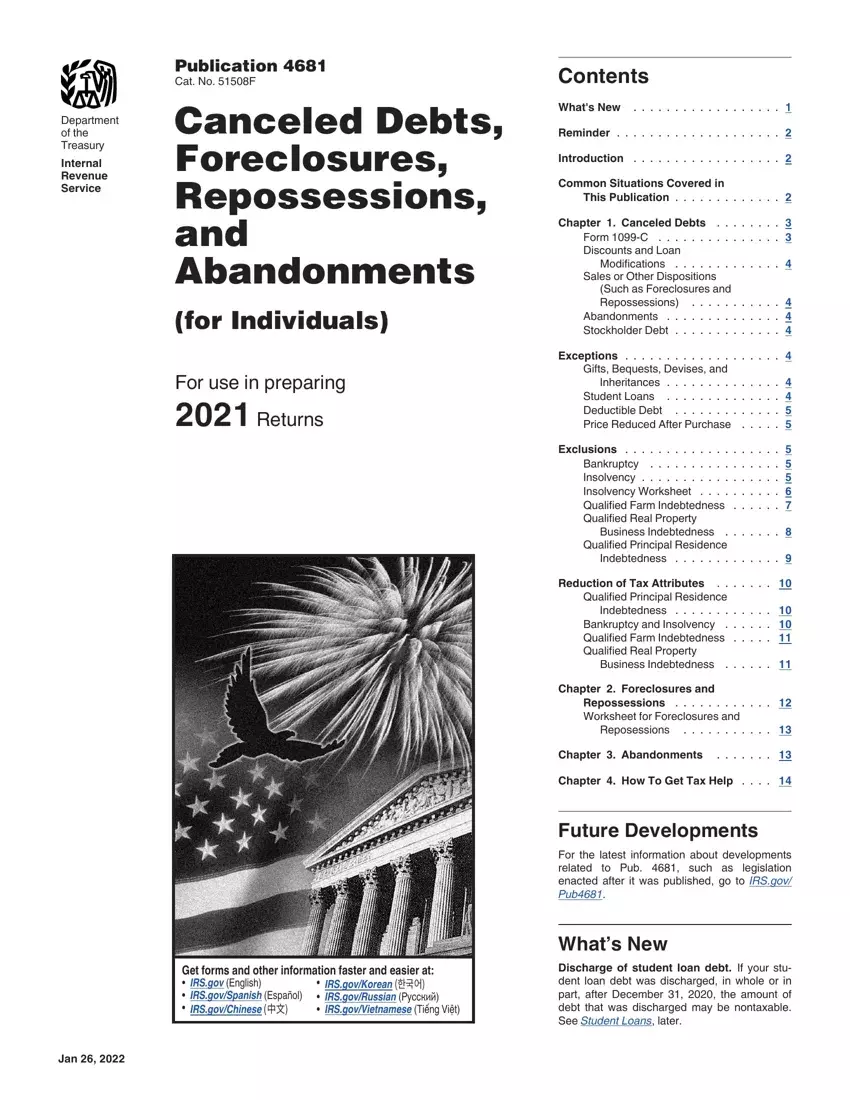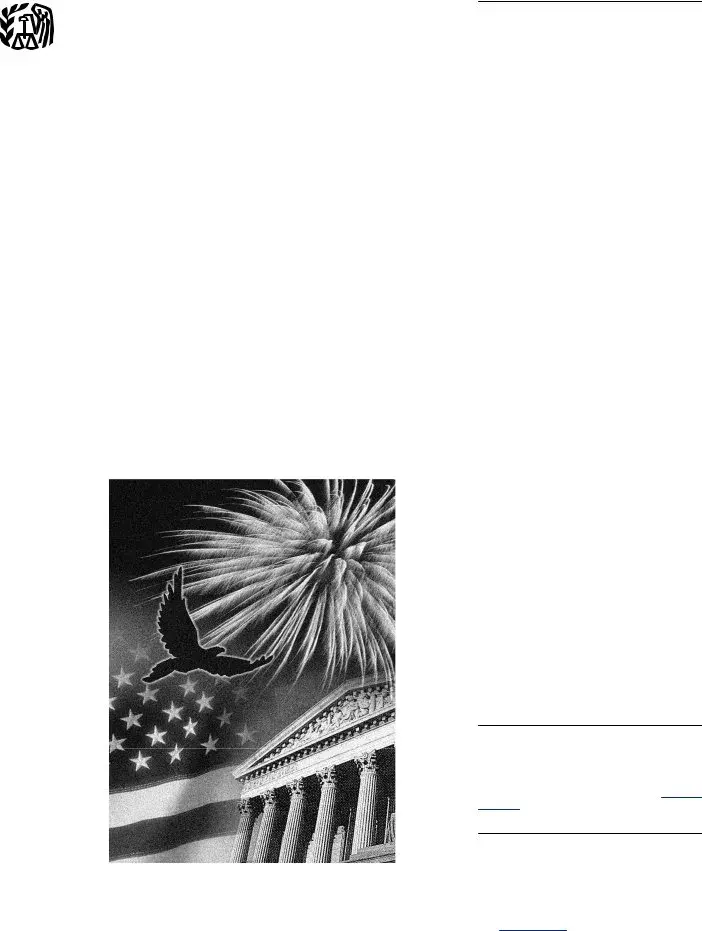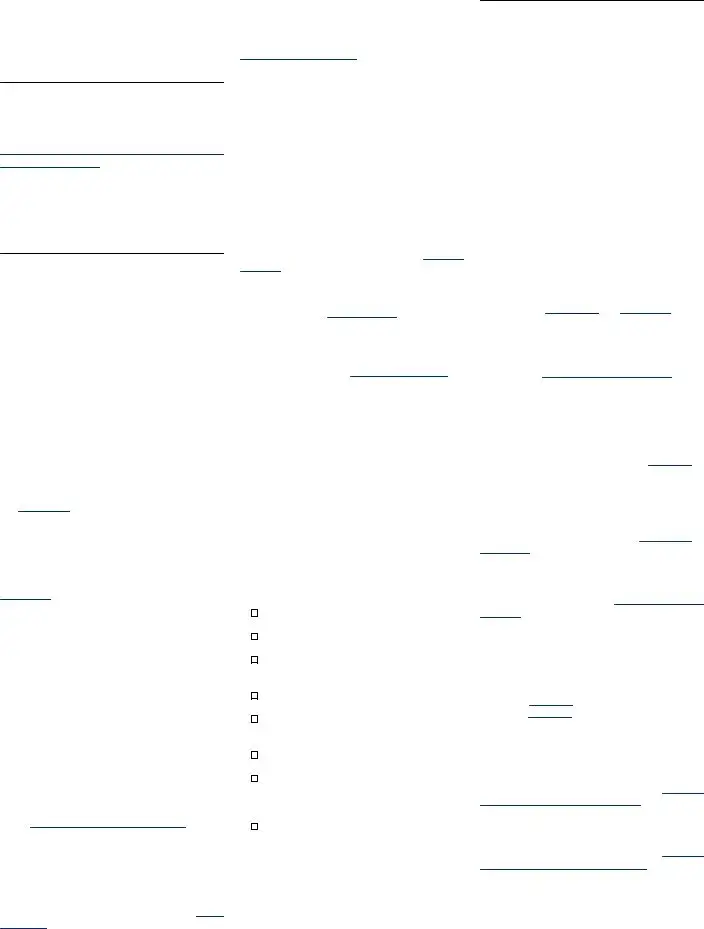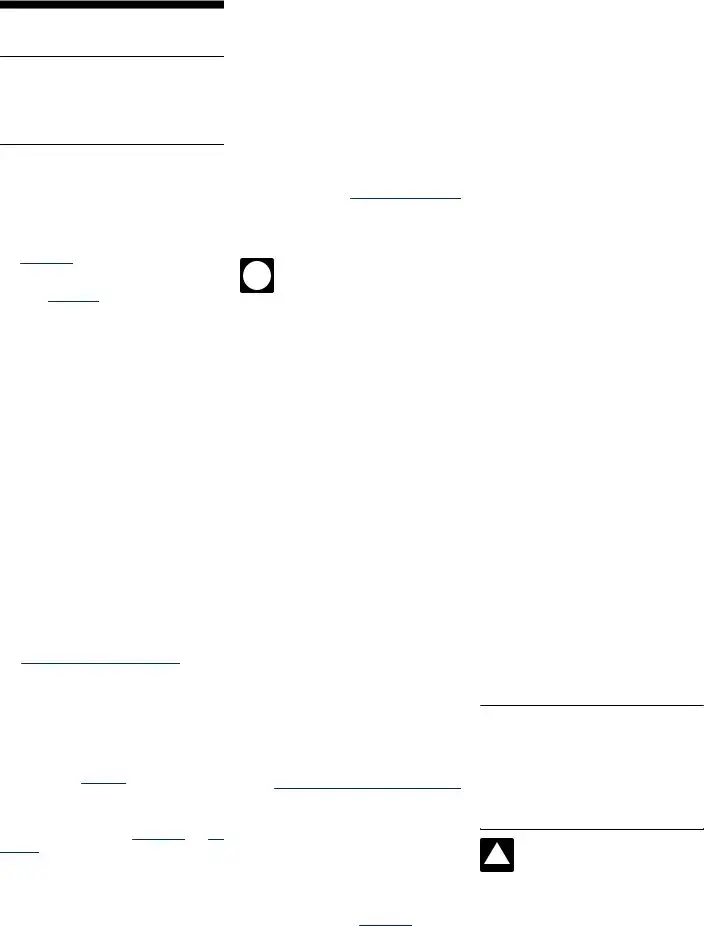Page 7
1. Any net operating loss (NOL) for 2021 and any NOL carryover to 2021.
Adjusted tax attributes. Adjusted tax at- tributes means the sum of the following items.
For more information about the basis of property, see Pub. 551.
Any canceled qualified farm debt that is more than this limit must be included in your in- come.
If you excluded canceled debt under the insol- vency exclusion, the adjusted basis of any qualified property and adjusted tax attributes are determined after any reduction of tax attrib- utes required under the insolvency exclusion.
2. The total adjusted basis of qualified prop- erty you held at the beginning of 2022.
1. Your adjusted tax attributes, and
For the definition of the term “related person,” see Related persons under At-Risk Amounts in Pub. 925, Passive Activity and At-Risk Rules.
Example 3—joint debt and separate re- turns. In 2021, James and his wife Robin were released from their obligation to pay a debt of $10,000 for which they were jointly and sever- ally liable. None of the exceptions to the general rule that canceled debt is included in income apply. They incurred the debt (originally $12,000) to finance James's purchase of a
$9,000 motorcycle and Robin's purchase of a Other exclusions must be applied before laptop computer and software for personal use the qualified farm indebtedness exclusion. for $3,000. They each received a 2021 Form This exclusion doesn't apply to a cancellation of 1099-C from the bank showing the entire can- debt in a title 11 bankruptcy case or to the ex- celed debt of $10,000 in box 2. Based on the tent you were insolvent immediately before the use of the loan proceeds, they agreed that cancellation. If qualified farm debt is canceled in James was responsible for 75% of the debt and a title 11 case, you must apply the bankruptcy Robin was responsible for the remaining 25%. exclusion rather than the exclusion for canceled Therefore, James's share of the debt is $7,500 qualified farm debt. If you were insolvent imme- (75% of $10,000), and Robin's share is $2,500 diately before the cancellation of qualified farm (25% of $10,000). By completing the Insolvency debt, you must apply the insolvency exclusion Worksheet, James determines that, immedi- before applying the exclusion for canceled ately before the cancellation of the debt, he was qualified farm debt.
insolvent to the extent of $5,000 ($15,000 total
liabilities minus $10,000 FMV of his total as- Exclusion limit. The amount of canceled sets). He can exclude $5,000 of his $7,500 can- qualified farm debt you can exclude from in- celed debt. Robin completes a separate Insol- come under this exclusion is limited. It can't be vency Worksheet and determines she was more than the sum of:
insolvent to the extent of $4,000 ($9,000 total li- abilities minus $5,000 FMV of her total assets). She can exclude her entire canceled debt of $2,500.
When completing his separate tax return, James checks the box on line 1b of Form 982 and enters $5,000 on line 2. He completes Part II to reduce his tax attributes as explained under Reduction of Tax Attributes, later. He must in- clude the remaining $2,500 (his $7,500 share of the canceled debt minus the $5,000 extent to which he was insolvent) of canceled debt on Schedule 1 (Form 1040), line 8c (unless an- other exclusion applies).
When completing her return, Robin checks the box on line 1b of Form 982 and enters $2,500 on line 2. She completes Part II to re- duce her tax attributes as explained under Re- duction of Tax Attributes, later. She doesn't in- clude any of the canceled debt on Schedule 1
You can exclude canceled farm debt from in- come on your 2021 return if all of the following apply.
• The debt was incurred directly in connec- tion with your operation of the trade or business of farming.
• 50% or more of your total gross receipts for 2018, 2019, and 2020 were from the trade or business of farming.
• The cancellation was made by a qualified person. A qualified person is an individual, organization, partnership, association, cor- poration, or other person who is actively and regularly engaged in the business of lending money. A qualified person also in- cludes any federal, state, or local govern- ment or agency or instrumentality of one of those governments. For example, the U.S. Department of Agriculture is a qualified person. A qualified person can't be related to you, can't be the person from whom you acquired the property (or a person related to this person), and can't be a person who receives a fee due to your investment in the property (or a person related to this person).
Example 2—amount of insolvency less than canceled debt. The facts are the same as in Example 1, except that Greg's total liabili- ties immediately before the cancellation were $10,000 and the FMV of his total assets imme- diately before the cancellation was $7,000. In this case, Greg is insolvent to the extent of $3,000 ($10,000 total liabilities minus $7,000 FMV of his total assets) immediately before the cancellation. Because the amount of the can- celed debt was more than the amount by which Greg was insolvent immediately before the can- cellation, Greg can exclude only $3,000 of the $5,000 canceled debt from income under the insolvency exclusion.
Greg checks the box on line 1b of Form 982 and includes $3,000 on line 2. Also, Greg com- pletes Part II to reduce his tax attributes as ex- plained under Reduction of Tax Attributes, later. Additionally, Greg must include $2,000 of can- celed debt on Schedule 1 (Form 1040), line 8c (unless another exclusion applies).
(Form 1040), line 8c. None of the canceled debt has to be included in her income.
Qualified Farm Indebtedness
Reduction of Tax Attributes, later. Greg doesn't include any of the $5,000 canceled debt on Schedule 1 (Form 1040), line 8c. None of the canceled debt is included in his income.
liabilities was more than the FMV of all of your assets immediately before the cancellation. For purposes of determining insolvency, assets in- clude the value of everything you own (includ- ing assets that serve as collateral for debt and exempt assets, which are beyond the reach of your creditors under the law, such as your inter- est in a pension plan and the value of your re- tirement account). Liabilities include:
•The entire amount of recourse debt;
•The amount of nonrecourse debt that isn't in excess of the FMV of the property that is security for the debt; and
•The amount of nonrecourse debt in excess of the FMV of the property subject to the nonrecourse debt, to the extent nonre- course debt in excess of the FMV of the property subject to the debt is forgiven.
You can use the Insolvency Worksheet TIP to help calculate the extent that you were insolvent immediately before the
cancellation.
Other exclusions must be applied before the insolvency exclusion. This exclusion doesn't apply to a cancellation of debt that oc- curs in a title 11 bankruptcy case. It also doesn't apply if the debt is qualified principal residence indebtedness (defined in this section under Qualified Principal Residence Indebtedness, later) unless you elect to apply the insolvency exclusion instead of the qualified principal resi- dence indebtedness exclusion.
How to report the insolvency exclusion. To show that you are excluding canceled debt from income under the insolvency exclusion, attach Form 982 to your federal income tax return and check the box on line 1b. On line 2, include the smaller of the amount of the debt canceled or the amount by which you were insolvent imme- diately before the cancellation. You can use the Insolvency Worksheet to help calculate the ex- tent that you were insolvent immediately before the cancellation. You must also reduce your tax attributes in Part II of Form 982 as explained un- der Reduction of Tax Attributes, later.
Example 1—amount of insolvency more than canceled debt. In 2021, Greg was re- leased from his obligation to pay his personal credit card debt in the amount of $5,000. Greg received a 2021 Form 1099-C from his credit card lender showing the entire amount of dis- charged debt of $5,000 in box 2. None of the exceptions to the general rule that canceled debt is included in income apply. Greg uses the Insolvency Worksheet to determine that his to- tal liabilities immediately before the cancellation were $15,000 and the FMV of his total assets immediately before the cancellation was $7,000. This means that immediately before the cancellation, Greg was insolvent to the extent of $8,000 ($15,000 total liabilities minus $7,000 FMV of his total assets). Because the amount by which Greg was insolvent immediately be- fore the cancellation was more than the amount of his debt canceled, Greg can exclude the en- tire $5,000 canceled debt from income.
When completing his tax return, Greg checks the box on line 1b of Form 982 and en- ters $5,000 on line 2. Greg completes Part II to reduce his tax attributes as explained under
Publication 4681 (2021)
